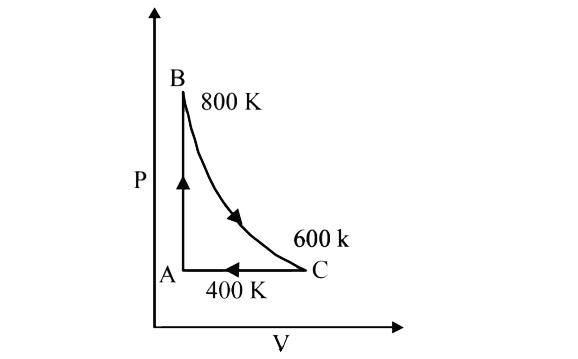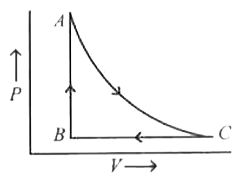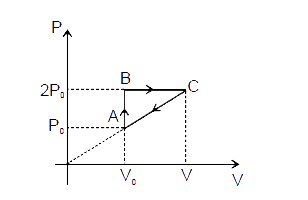One mole of diatomic ideal gas undergoes a cyclic process ABC as show in figure . The process BC is adiabatic. The temperature at A,B and C are 400K, 800Kand 600 K, respectively . Choose the correct statement.

The Change in internal energy in whole cyclic process is 250R
The change in internal energy in the process CA is 700R
The change in internal energy in the process AB is −350R
The change in internal energy in the processBC is −500R
The correct Answer is:D
For diatomic gas , Cv=5R2
Energy ΔU=nCvΔT=1×ΔT
For BC ΔT=−200K⇒ΔU=−500R
Topper's Solved these Questions
- KINETIC THEORY OF GASES ANDRADIATIONBOOK - MHTCET PREVIOUS YEAR PAPERS AND PRACTICE PAPERSCHAPTER - KINETIC THEORY OF GASES ANDRADIATIONEXERCISE - Exercise 2
50 Videos
- KINETIC THEORY OF GASES ANDRADIATIONBOOK - MHTCET PREVIOUS YEAR PAPERS AND PRACTICE PAPERSCHAPTER - KINETIC THEORY OF GASES ANDRADIATIONEXERCISE - MHT CET Corner
40 Videos
- KINETIC THEORY OF GASES ANDRADIATIONBOOK - MHTCET PREVIOUS YEAR PAPERS AND PRACTICE PAPERSCHAPTER - KINETIC THEORY OF GASES ANDRADIATIONEXERCISE - MHT CET Corner
40 Videos
- INTERFERENCE AND DIFFRACTION OF LIGHT BOOK - MHTCET PREVIOUS YEAR PAPERS AND PRACTICE PAPERSCHAPTER - INTERFERENCE AND DIFFRACTION OF LIGHT EXERCISE - MHT CET Corner
24 Videos
- MAGNETIC EFFECT OF ELECTRIC CURRENTBOOK - MHTCET PREVIOUS YEAR PAPERS AND PRACTICE PAPERSCHAPTER - MAGNETIC EFFECT OF ELECTRIC CURRENTEXERCISE - MHT CET CORNER
20 Videos
Similar Questions
One mole of a diatomic ideal gas undergoes a cyclic process ABC as shown in figure. The process BC is adiabatic. The temperature at A,B and C are 400K, 800K and 600K respectively. Choose the correct statement:

View SolutionOne mole of a diatomic ideal gas undergoes a cyclic process ABC as shown in figure. The process BC is adiabatic. The temperature at A,B and C are 400K, 800K and 600K respectively. Choose the correct statement:

View Solution
Knowledge Check
One mole of a diatomic ideal gas undergoes a cyclic process ABC as shown in figure. The process BC is adiabatic. The temperature at A,B and C are 400K, 800K and 600K respectively. Choose the correct statement:
 AThe change in internal energy in whole cyclic process is 250R.BThe change in internal process CA is 700R.CThe change in internal energy in the process AB is -350R.DThe chang in internal energy in the process BC is -500R.
AThe change in internal energy in whole cyclic process is 250R.BThe change in internal process CA is 700R.CThe change in internal energy in the process AB is -350R.DThe chang in internal energy in the process BC is -500R.One mole of ideal gas undergoes a cyclic process ACBA as shown in figure. Process AC is adiabatic. The temperatures at 1, B and C are 300 K,600 K and 450 K respectively. Choose the correct statement.
 AIn process CA, change in internal energy is 225 R.BIn process AB, change in internal energy is -150 RCIn process BC, change in intenal energy is -225 R.DChange in internal energy during the whole cyclic process is +150 R.
AIn process CA, change in internal energy is 225 R.BIn process AB, change in internal energy is -150 RCIn process BC, change in intenal energy is -225 R.DChange in internal energy during the whole cyclic process is +150 R.One mole of a monatomic ideal gas undergoes a cyclic process as shown in the figure (where V is the volume and T is the temperature). Which of the statements below is (are) true?
 AProcess I is an isochoric processBIn process II, gas absorbs heatCIn process IV, gas releases heatDProcesses I and III are not isobaric
AProcess I is an isochoric processBIn process II, gas absorbs heatCIn process IV, gas releases heatDProcesses I and III are not isobaric
n moles of a diatomic gas has undergone a cyclic process ABC as shown in figure. Temperature at A is T0. Find

Maximum temperatue ?
View Solutionn moles of a diatomic gas has undergone a cyclic process ABC as shown in figure. Temperature at A is T0. Find

Volume at C ?
View Solutionn moles of a diatomic gas has undergone a cyclic process ABC as shown in figure. Temperature at a is T0. Find volume at C

View Solutionn moles of a diatomic gas has undergone a cyclic process ABC as shown in figure. Temperature at A is T0. Find
 Total heat given to gas ?
Total heat given to gas ?
View Solutionn moles of a diatomic gas has undergone a cyclic process ABC as shown in figure. Temperature at A is T0. Find

Find out the efficiency
View Solution
